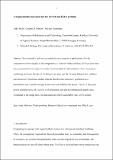Files in this item
A non-parametric maximum test for the Behrens–Fisher problem
Item metadata
| dc.contributor.author | Welz, Anke | |
| dc.contributor.author | Ruxton, Graeme D. | |
| dc.contributor.author | Neuhäuser, Markus | |
| dc.date.accessioned | 2019-01-31T00:33:41Z | |
| dc.date.available | 2019-01-31T00:33:41Z | |
| dc.date.issued | 2018-03 | |
| dc.identifier | 252572639 | |
| dc.identifier | 813ee662-6fd4-4be1-a939-68a4e7ceb514 | |
| dc.identifier | 85041347412 | |
| dc.identifier | 000426935100006 | |
| dc.identifier.citation | Welz , A , Ruxton , G D & Neuhäuser , M 2018 , ' A non-parametric maximum test for the Behrens–Fisher problem ' , Journal of Statistical Computation and Simulation , vol. 88 , no. 7 , pp. 1336-1347 . https://doi.org/10.1080/00949655.2018.1431236 | en |
| dc.identifier.issn | 0094-9655 | |
| dc.identifier.other | RIS: urn:4708DC6BF3FF757918B6A318EC324339 | |
| dc.identifier.other | ORCID: /0000-0001-8943-6609/work/60427496 | |
| dc.identifier.uri | https://hdl.handle.net/10023/16969 | |
| dc.description.abstract | Non-normality and heteroscedasticity are common in applications. For the comparison of two samples in the non-parametric Behrens-Fisher problem, different tests have been proposed, but no single test can be recommended for all situations. Here, we propose combining two tests, the Welch t test based on ranks and the Brunner-Munzel test, within a maximum test. Simulation studies indicate that this maximum test, performed as a permutation test, controls the type I error rate and stabilizes the power. That is, it has good power characteristics for a variety of distributions, and also for unbalanced sample sizes. Compared to the single tests, the maximum test shows acceptable type I error control. | |
| dc.format.extent | 12 | |
| dc.format.extent | 880964 | |
| dc.language.iso | eng | |
| dc.relation.ispartof | Journal of Statistical Computation and Simulation | en |
| dc.subject | Behrens-Fisher problem | en |
| dc.subject | Brunner-Munzel test | en |
| dc.subject | Maximum test | en |
| dc.subject | Welch t test | en |
| dc.subject | QA Mathematics | en |
| dc.subject | QA75 Electronic computers. Computer science | en |
| dc.subject | DAS | en |
| dc.subject.lcc | QA | en |
| dc.subject.lcc | QA75 | en |
| dc.title | A non-parametric maximum test for the Behrens–Fisher problem | en |
| dc.type | Journal article | en |
| dc.contributor.institution | University of St Andrews. School of Biology | en |
| dc.contributor.institution | University of St Andrews. Centre for Biological Diversity | en |
| dc.identifier.doi | https://doi.org/10.1080/00949655.2018.1431236 | |
| dc.description.status | Peer reviewed | en |
| dc.date.embargoedUntil | 2019-01-31 |
This item appears in the following Collection(s)
Items in the St Andrews Research Repository are protected by copyright, with all rights reserved, unless otherwise indicated.

